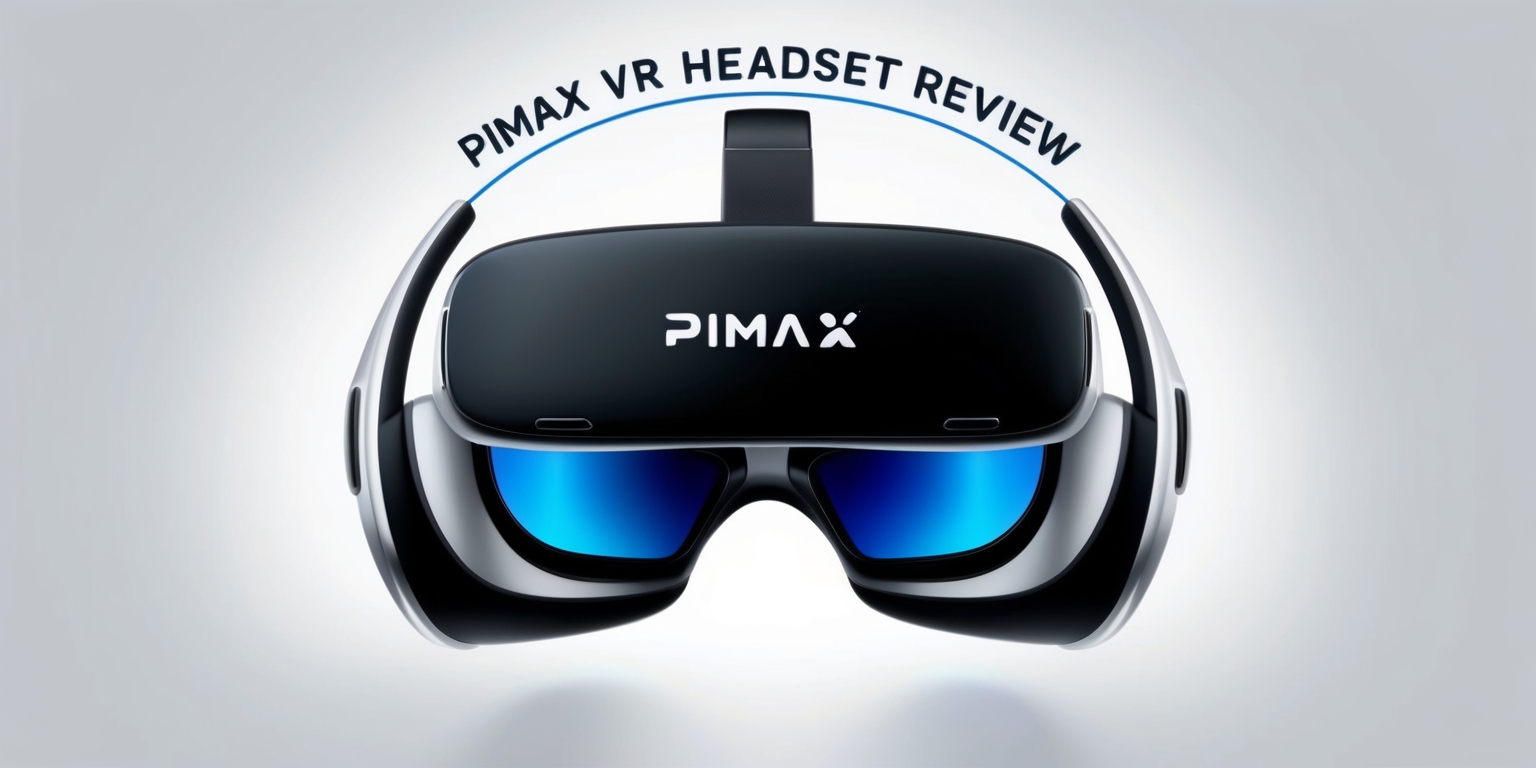Industrial Ingenuity Meets Immersive Innovation: A Deep Dive into Pimax’s VR Evolution
23 May, 2025

The realm of virtual reality continues to forge new territories as both hardware and software relentlessly evolve. In this rapidly shifting landscape, several companies have emerged with innovative attempts to challenge mainstream headsets. Among these, Pimax has established a niche reputation over the past decade by designing products that push the boundaries of what immersive systems can achieve. The latest iteration from the company has sparked curiosity among enthusiasts, promising a blend of high-end display technology and cutting-edge design choices. This fresh offering aims to bridge the gap between technical achievement and usability, though its roots within a complex history of experimental hardware shine through. The experience unfolds as an exploration into design philosophy, technical integration, and the nuanced demands of high-fidelity gaming.
Legacy and Technological Evolution
Pimax’s journey in virtual reality spans nearly ten years, marked by both pioneering advancements and notable setbacks. With each iteration, the company has aimed to elevate visual fidelity and performance standards in VR gaming. This latest model reflects an effort to strip down some of the complexities that troubled its previous versions while retaining the brilliance of its signature display capabilities. Historically, Pimax was known to experiment with various design elements that occasionally hindered ease of use. However, this new release signals a decisive step into a more refined direction. The emphasis on high-end visuals is evident, as it leverages advanced display technology that provides remarkably detailed images. Yet, the journey reveals a balancing act between innovation and practicality, a constant challenge confronted by many in this era of immersive entertainment.
Industrial Design and Aesthetic Choices
The physical form of the headset reflects an industrial design language that departs from the trend of sleek, compact alternatives. The Crystal Light channels a utilitarian spirit, borrowing much from its more fully specced predecessor. Its robust, angular contours evoke a tool crafted for functionality over cosmetic appeal. While many modern headsets strive for a minimalistic silhouette to enhance wearability, this model’s bold shape gives it a distinctive, albeit clunky, presence on the face. Emphasizing practicality, the design opts for familiar elements that come with inherent trade-offs. The durability is suggested through hard plastic construction that feels utilitarian, yet some refinements in ergonomics seem sacrificed in favor of retaining performance-focused components. The industrial aesthetic augments its tech-centric narrative, appealing primarily to enthusiasts willing to embrace form over fashion.
Ergonomics and User Comfort
The headset’s fit and comfort remain pivotal in determining its success during prolonged use, and here the design presents mixed impressions. Weighing just over 800 grams, it manages to stay within an acceptable range compared to other high-end competitors. However, the balance is notably skewed towards a front-heavy construction, impacting the natural ergonomics during active gameplay. The adjustable head strap, designed with rigid arms and a ratchet system, offers some room for personalization, yet the triangular rear pad does not effectively counterbalance the weight. Users may experience discomfort due to occasional collisions with hand-held controllers, particularly when engaging in fast-paced movements. Despite these challenges, the design does offer some merits, as the robust construction may inspire confidence in its durability over extended sessions. The emphasis on a functional rather than refined comfort highlights its niche positioning in the market.
Display Excellence and Visual Immersion

Among the standout facets of this VR system entails fusing state-of-the-art screen technology that beams with vibrant clarity. The headset employs 2880x2880 per eye QLED panels that deliver richly saturated images and profoundly dark blacks, crafting an immersive visual tapestry. As users step into the virtual realm, the crispness and vivid detail redefine what is expected from VR graphics. Such high-resolution displays are particularly rewarding in static simulation experiences or scenarios that demand precise visual detail, such as cockpit simulations or intricate virtual environments. Although the field of view might feel somewhat restricted compared to wider-range competitors, the eye-candy provided by these displays is undeniably compelling. This system serves as compelling proof of the untapped promise within… high-resolution panels in crafting environments that feel both lifelike and artistically compelling.
Connectivity and Simplified Hardware Integration
This headset diverges from the popular wireless model trend by adopting a wired-only approach, a decision that carries its own set of implications. By eschewing complex modular systems for a single, three-pronged cable, the connection process becomes more straightforward yet tethered to the physical constraints of cables. The required connections, comprising a USB 3.0 port, a DisplayPort, and an external power supply, are bundled into a single solution designed to reduce technical confusion. This streamlined methodology has the potential to minimize setup errors often encountered in more complicated systems. However, the firmness of the cable, its limited length, and the intrusive nature of the tether may impede free movement. This aspect emphasizes a commitment to robust connectivity, Although it may necessitate sacrificing a certain extent of… agility and untethered play that modern gamers may expect.
Software Experience and Interface Challenges
The integration of the hardware with its accompanying software remains a critical factor in defining the overall user experience. The desktop app developed by Pimax is designed to manage this specialty headset seamlessly, recognizing the device quickly and interfacing well with established platforms like SteamVR. Despite this, the user interface within the app appears crowded with an array of controls—checkboxes, dropdown menus, and adjustable sliders. The lack of a clear and guided setup process might be daunting for those less versed in VR systems. The intricate configuration options underscore the headset's orientation towards advanced users, leaving newcomers with a steep learning curve. While experienced operators may appreciate the level of customization available, the software demands a willingness to engage deeply with technical parameters to achieve optimal performance.
Gameplay Dynamics and Immersive Interaction
When venturing into the world of active VR gaming, the headset's performance in dynamic scenarios reveals both strengths and shortcomings. For titles requiring rapid head movements and precise tracking, issues such as stutters and disconnections can disrupt the overall experience. The wired connection, though reliable in theory, introduces physical restrictions that may detract from full immersion in high-action environments. Games that depend on nuanced controller tracking sometimes suffer from jittery or imprecise responses during vigorous movements. This weakness becomes particularly evident in titles where the interplay between the headset and hand-held units is critical. Even though the advanced displays offer outstanding visuals, the combination of physical tethering and occasional calibration hiccups presents challenges that could frustrate players looking for a seamless, quick-to-play experience.
Controller Performance and Tracking Reliability
The operational efficiency of VR peripherals lies at the heart of any immersive gaming setup, and this system’s controllers underline a mixed performance record. Utilizing inside-out tracking mechanisms, these controllers are designed to interpret nuanced hand movements and translate them into in-game gestures. However, during active gameplay, some irregularities become apparent; even minor shifts can introduce momentary tracking lapses that disturb the virtual environment. The physical design of the controllers features pronounced plastic tracking rings, which may inadvertently interact with the headset's structure during swift movements. While the controllers resemble professional-grade units on paper, their tactile feel and gripping texture are reminiscent of more basic offerings. The reliability of tracking technology is central for a fluid VR experience, and though inventive, these controllers signal that refinements are necessary for consistent performance across varied gameplay scenarios.
Pushing the Envelope of Simulation and Visual Fidelity
High-resolution immersive technology finds one of its strongest expressions in simulation-based applications, and this headset aims to be the premier choice for such niche uses. In virtual environments where precision is paramount—such as detailed driving simulators or complex control panels—the clarity offered by the QLED displays is nothing short of remarkable. Every dial, every minute text detail, and even the subtlest visual enhancements are delivered with a vividness that invites prolonged scrutiny. This emphasis on visual fidelity can transform a routine simulation into an extraordinarily engaging experience, provided that the computing hardware behind it can support the level of detail required. Although this headset aims to offer the sharpest visual output in gaming scenarios, its strengths are best realized in controlled, less physically interactive environments where static visual clarity takes precedence over rapid motion and dynamic response.
Market Positioning and Niche Appeal
Within a competitive landscape populated by mainstream VR solutions, this headset occupies a distinctive niche that revolves around high-resolution performance and technical ambition. With a price point significantly higher than several well-known stand-alone brands, it appeals primarily to those who prioritize technological sophistication over immediate plug-and-play convenience. Its advanced but complicated setup, combined with a design that hints at industrial efficiency rather than consumer polish, positions it more as a tech demonstrator than a mass-market solution. The product caters to a specialized audience that is willing to invest in peripheral improvements and invest time in system optimization. In this light, its offerings are a bold declaration of intent to push the limits of visual immersion, appealing especially to professionals or enthusiasts who favor high-end simulation environments over mainstream gaming simplicity.
Hardware Requirements and Computing Considerations
Driving the impressive power of its displays necessitates considerable processing resources, a detail that may present challenges for many potential users. The headset’s advanced imaging capabilities leverage technology that demands a robust PC configuration to avoid performance degradation. When connected to systems with mid-range specifications, the device may experience issues such as tearing or reduced frame rates, particularly during graphically intensive operations. This dependency on high-end hardware underscores the headset’s ambition to offer a premium visual experience, but it simultaneously restricts its accessibility to those with top-of-the-line gaming setups. Gamers and simulation enthusiasts must be prepared to invest in systems capable of harnessing the full potential of these displays. The requirement for substantial computing power effectively reinforces its placement as a device intended for specialized, performance-focused environments rather than casual home entertainment.







